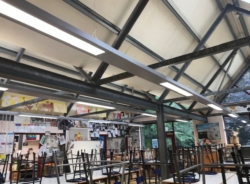How to Get Funding for Your School’s Energy Saving Project
If you’re planning an energy efficiency upgrade in your school, interest-free loans are available from Salix, a government-funded, independent, not-for-profit company. Since 2012, more than £17.5 million has been allocated to 650 maintained schools, as well as £31 million for 600 academies for energy efficiency improvements, that have reduced utility bills, freeing up precious funds for educational use.
The loans are repaid with savings on energy bills. Salix supports 120 different types of energy efficient technologies, with the most popular schools projects being LED lighting, boiler upgrades, heating and insulation. The repayments are recycled to fund further projects in the public sector.
While the loans are 100% interest-free, the application process is (necessarily) complicated. Here is a guide to the detailed application procedures that need to be followed precisely to avoid issues and potential funding failure.


How to apply
There are two main criteria for the interest-free funding:
- Energy-saving projects must pay for themselves within eight years through the predicted yearly energy savings
- A project cannot exceed a maximum cost of £200 per tonne of carbon dioxide saved (calculated using the Salix compliance tool).
The loan will be repaid over a minimum of five years with flexibility up to a maximum of eight years – this depends on the rate of payback from energy-bill savings. The loans are paid to Salix by direct debit every April and October.
Each project has to be completed nine months from the commitment date and allowance will be made for projects that have to be tendered after agreement to fund.
The application process is in two stages:
- Application, project assessment and commitment to fund
- Completion of the project with loan set up and payment of funds, unless Salix agrees to fund on an interim payment basis.
If a school has a project that not fully meet the eight-year payback but has funding available from another source, then an application for partial funding can be made.
Projects that increase in cost to the point that they no longer comply with the criteria cannot be funded unless the school is prepared to cover the additional costs.
This means that it is essential for project assessments to be thorough and that project management during installation is well controlled. Projects that are not completed within the agreed schedule will also not be funded, unless valid reasons for more time are agreed by Salix.
Eligibility
Only those projects where energy savings go directly to the school during the project’s agreed lifetime will be considered.
Example of projects that fall outside the criteria include outsourced estate management contracts where the supplier pays energy bills and so would benefit from savings achieved. But if the energy bill was a “pass-through” under the contract and the school benefitted from the energy savings, then the project would be eligible.
It is assumed that the applicant and partners they work with are competent and fully responsible for the projects to be funded. This includes:
- Project identification and development
- Establishment of agreed costs and fully-calculated estimated savings
- Reasonable project sequencing and due care to ensure no double counting of savings when considering multiple projects on the same site
- Selection of suitable supplier following individual procurement procedures
- Project delivery, including project management
- Post-project completion activities, including verification of savings.
There is a minimum value for any single project of £500 and a total minimum application and loan value of £5,000. There is no maximum loan value. Project management costs can be included in the loan, as long as the application remains compliant. Salix can provide interim/stage payments to assist with advance payment requirements.
To help assess whether projects meet the payback and £200/tCO2 criteria, Salix provides a Project Compliance Tool. This is Excel-based and used by applicants to input information on project costs, estimated savings, technology type and building life expectancy. The tool automatically calculates whether the project is compliant.
However, this does not mean that the application will be approved or loan funding granted. The tool contains a list of the technologies currently funded by Salix.
Maintained schools have been granted blanket approval by the Secretary of State to apply for Salix loans. Schools that are converting to academies are required to transfer any loans they have. The loan transfer can be fulfilled by signing a novation agreement, providing consent and revised bank details.
There is a five-step process for Salix loan applications:
Step 1: Sign up to the Salix website.
Step 2: Download and complete the Compliance Tool.
Step 3: Complete the online Application Form, attaching the Compliance Tool and supporting information.
Step 4: Automated email is generated and sent to the authorising official to approve.
Step 5: Application is assessed and a decision typically made within two weeks.
The online application must also be given approval by the authorising official at the school by email to Salix before assessment can begin.


The process is exhaustive and time-consuming but the rewards are worth the effort and at SaveMoneyCutCarbon, we have found that many schools prefer to be guided by experts. Our team utilises its deep knowledge gained from years of successful Salix applications to take the strain.
SaveMoneyCutCarbon offers a complete Salix service at no cost to the public sector. We have a dedicated Salix bid team with a proven track record in securing funding from Salix Finance, project managing your Salix funded project from the outset and installing the very best energy saving technology at times that suit you.


















